2016《中考王》英语命题研究(怀化)中考英语语法专题突破:专题十动词的时态
文档属性
| 名称 | 2016《中考王》英语命题研究(怀化)中考英语语法专题突破:专题十动词的时态 | 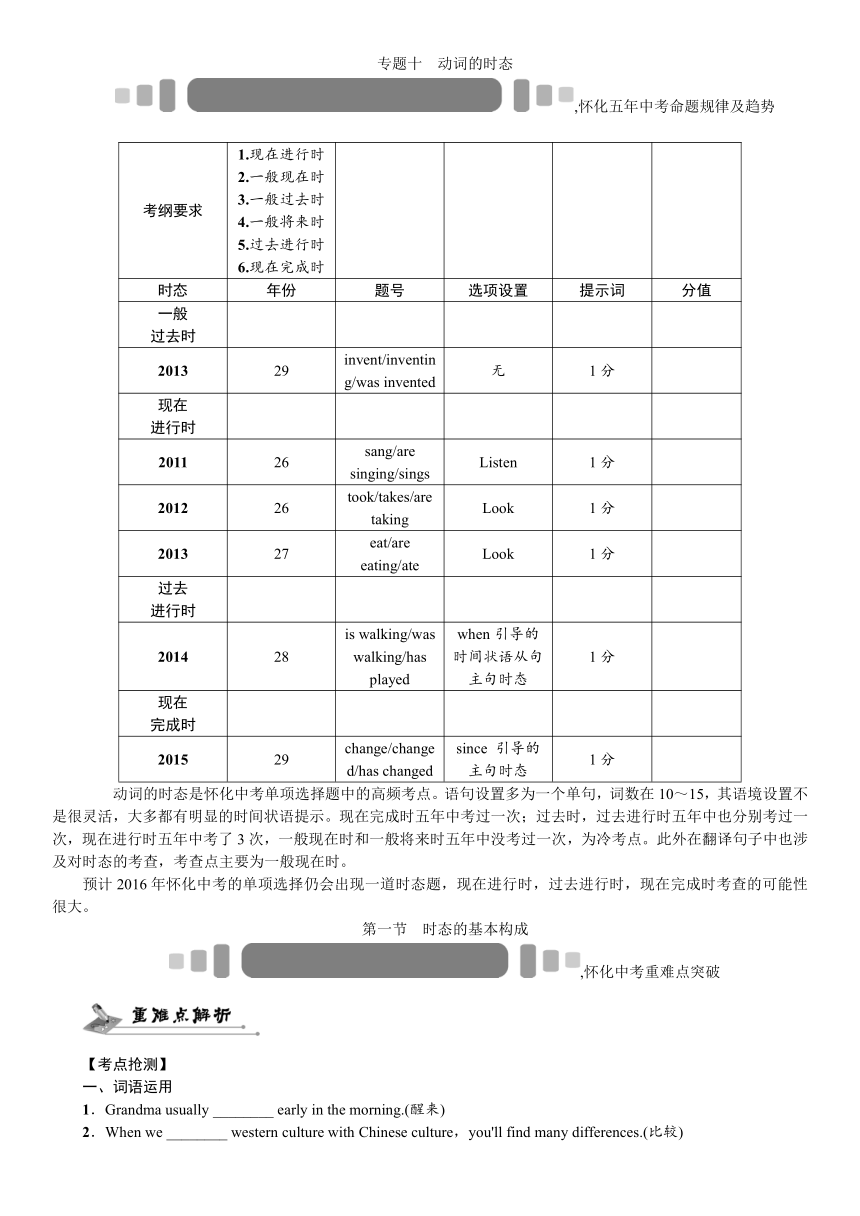 | |
| 格式 | zip | ||
| 文件大小 | 190.7KB | ||
| 资源类型 | 教案 | ||
| 版本资源 | 通用版 | ||
| 科目 | 英语 | ||
| 更新时间 | 2016-04-17 08:20:37 | ||
图片预览

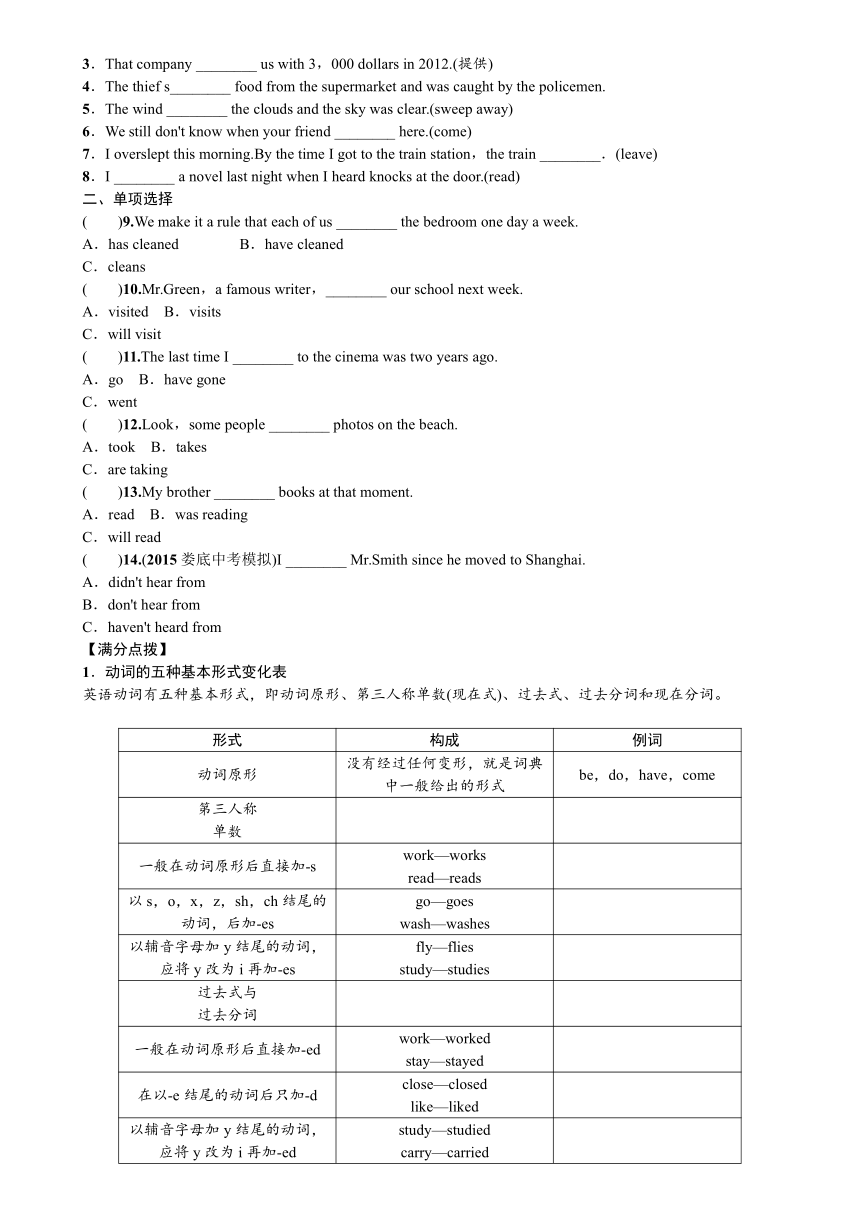
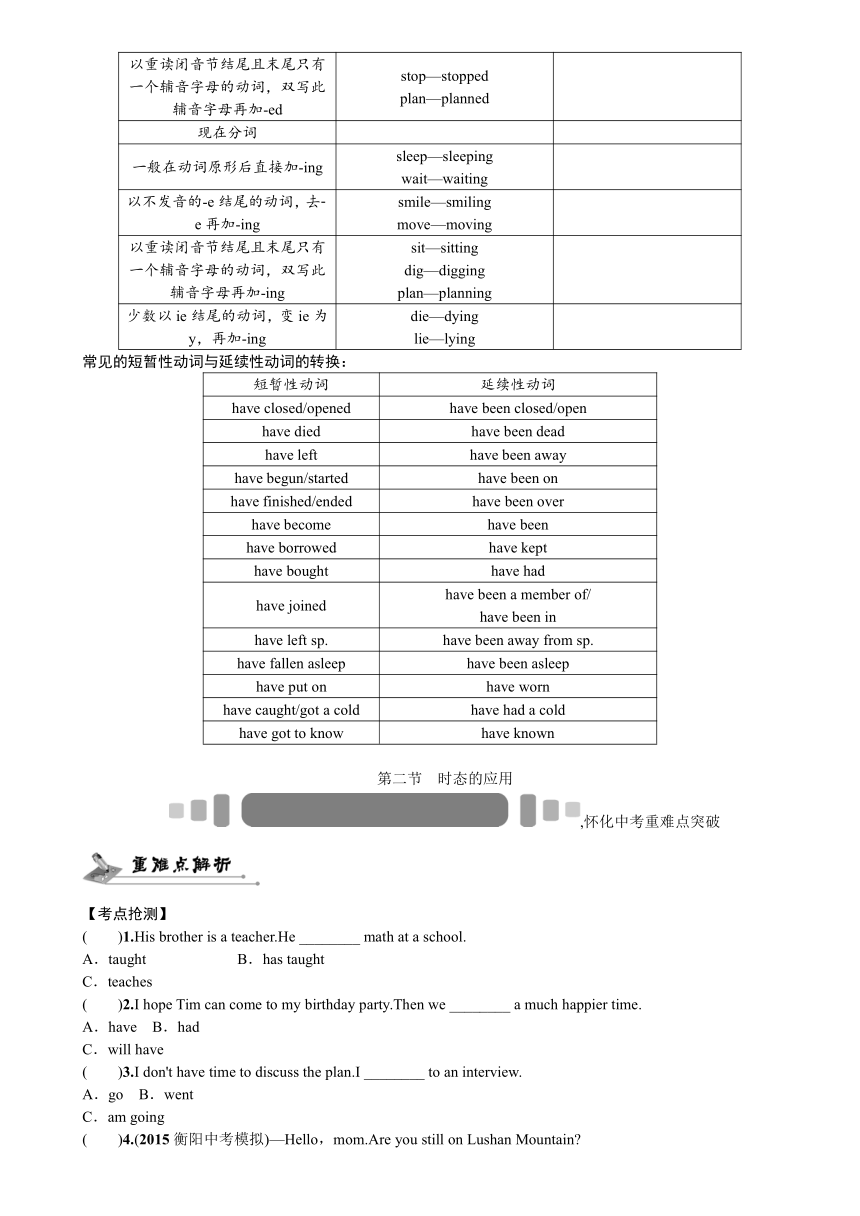
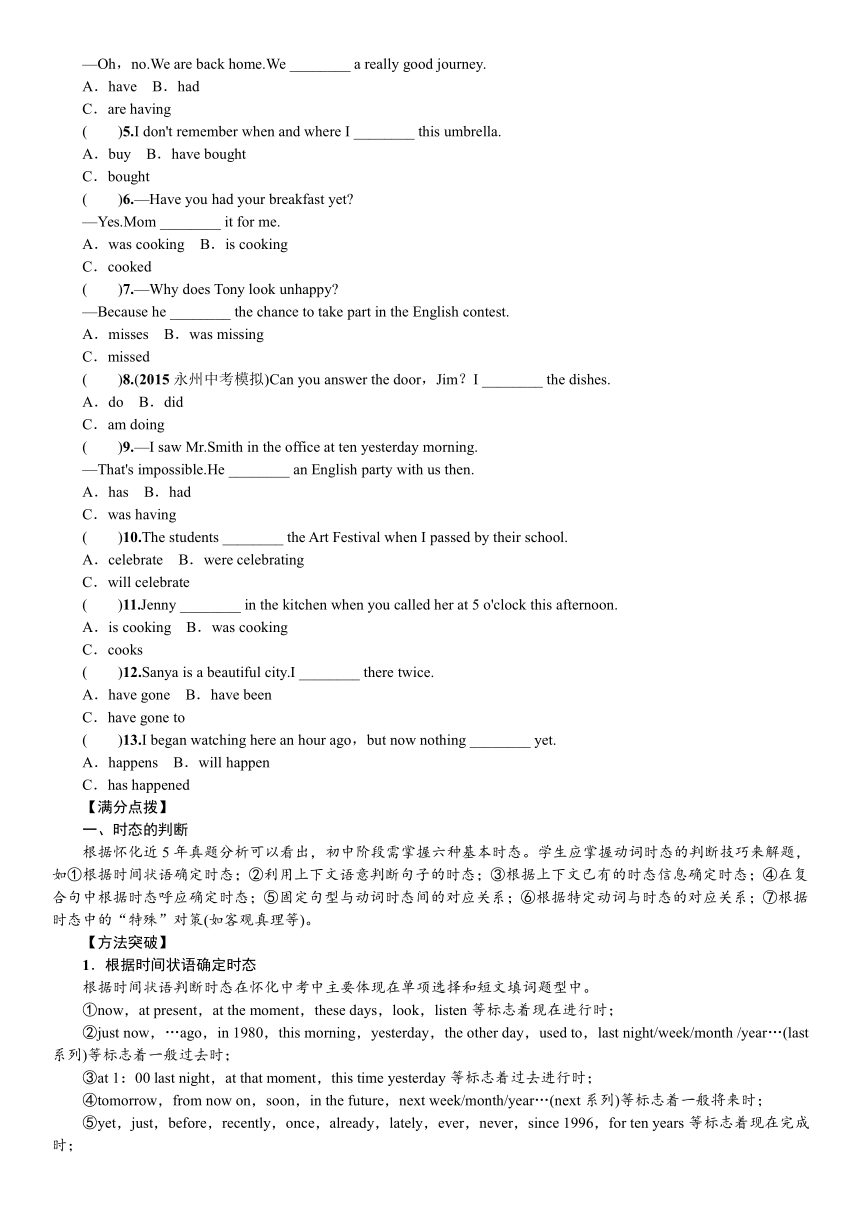
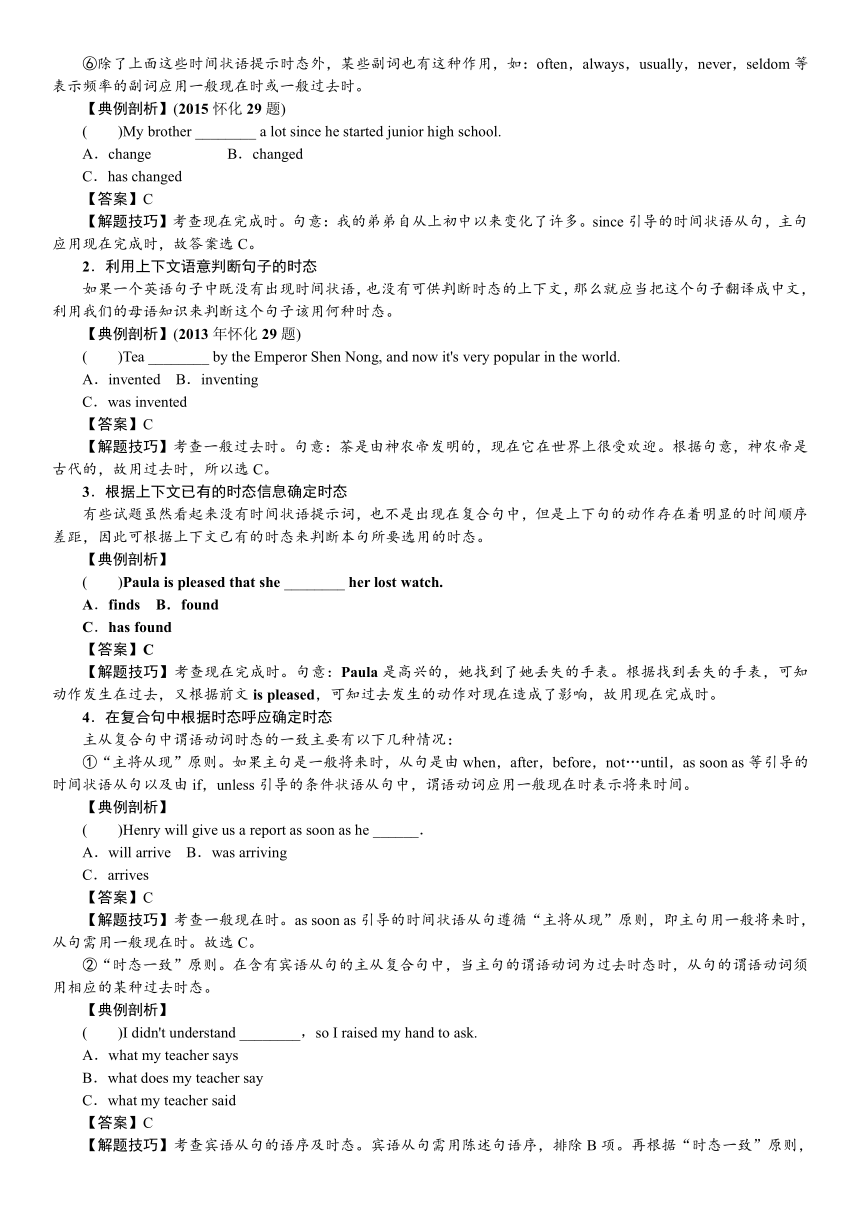
文档简介
专题十 动词的时态
,怀化五年中考命题规律及趋势
考纲要求 1.现在进行时 2.一般现在时 3.一般过去时 4.一般将来时 5.过去进行时 6.现在完成时
时态 年份 题号 选项设置 提示词 分值
一般过去时
2013 29 invent/inventing/was invented 无 1分
现在进行时
2011 26 sang/are singing/sings Listen 1分
2012 26 took/takes/are taking Look 1分
2013 27 eat/are eating/ate Look 1分
过去进行时
2014 28 is walking/was walking/has played when引导的时间状语从句主句时态 1分
现在完成时
2015 29 change/changed/has changed since 引导的主句时态 1分
动词的时态是怀化中考单项选择题中的高 ( http: / / www.21cnjy.com )频考点。语句设置多为一个单句,词数在10~15,其语境设置不是很灵活,大多都有明显的时间状语提示。现在完成时五年中考过一次;过去时,过去进行时五年中也分别考过一次,现在进行时五年中考了3次,一般现在时和一般将来时五年中没考过一次,为冷考点。此外在翻译句子中也涉及对时态的考查,考查点主要为一般现在时。
预计2016年怀化中考的单项选择仍会出现一道时态题,现在进行时,过去进行时,现在完成时考查的可能性很大。
第一节 时态的基本构成
,怀化中考重难点突破
【考点抢测】
一、词语运用
1.Grandma usually ________ early in the morning.(醒来)
2.When we ________ western culture with Chinese culture,you'll find many differences.(比较)
3.That company ________ us with 3,000 dollars in 2012.(提供)
4.The thief s________ food from the supermarket and was caught by the policemen.
5.The wind ________ the clouds and the sky was clear.(sweep away)
6.We still don't know when your friend ________ here.(come)
7.I overslept ( http: / / www.21cnjy.com ) this morning.By the time I got to the train station,the train ________.(leave)
8.I ________ a nove ( http: / / www.21cnjy.com )l last night when I heard knocks at the door.(read)
二、单项选择
( )9.We make it ( http: / / www.21cnjy.com )a rule that each of us ________ the bedroom one day a week.
A.has cleaned B.have cleaned
C.cleans
( )10.Mr.Green,a famous writer,________ our school next week.
A.visited B.visits
C.will visit
( )11.The last time I ________ to the cinema was two years ago.
A.go B.have gone
C.went
( )12.Look,some people ________ photos on the beach.
A.took B.takes
C.are taking
( )13.My brother ________ books at that moment.
A.read B.was reading
C.will read
( )14.(2015娄底中考模拟)I ________ Mr.Smith since he moved to Shanghai.
A.didn't hear from
B.don't hear from
C.haven't heard from
【满分点拨】
1.动词的五种基本形式变化表
英语动词有五种基本形式,即动词原形、第三人称单数(现在式)、过去式、过去分词和现在分词。
形式 构成 例词
动词原形 没有经过任何变形,就是词典中一般给出的形式 be,do,have,come
第三人称单数
一般在动词原形后直接加 s work—worksread—reads
以s,o,x,z,sh,ch结尾的动词,后加 es go—goeswash—washes
以辅音字母加y结尾的动词,应将y改为i再加 es fly—fliesstudy—studies
过去式与过去分词
一般在动词原形后直接加 ed work—workedstay—stayed
在以 e结尾的动词后只加 d close—closedlike—liked
以辅音字母加y结尾的动词,应将y改为i再加 ed study—studiedcarry—carried
以重读闭音节结尾且末尾只有一个辅音字母的动词,双写此辅音字母再加 ed stop—stoppedplan—planned
现在分词
一般在动词原形后直接加 ing sleep—sleepingwait—waiting
以不发音的 e结尾的动词,去 e再加 ing smile—smilingmove—moving
以重读闭音节结尾且末尾只有一个辅音字母的动词,双写此辅音字母再加 ing sit—sittingdig—diggingplan—planning
少数以ie结尾的动词,变ie为y,再加 ing die—dyinglie—lying
常见的短暂性动词与延续性动词的转换:
短暂性动词 延续性动词
have closed/opened have been closed/open
have died have been dead
have left have been away
have begun/started have been on
have finished/ended have been over
have become have been
have borrowed have kept
have bought have had
have joined have been a member of/have been in
have left sp. have been away from sp.
have fallen asleep have been asleep
have put on have worn
have caught/got a cold have had a cold
have got to know have known
第二节 时态的应用
,怀化中考重难点突破
【考点抢测】
( )1.His brother is a teacher.He ________ math at a school.
A.taught B.has taught
C.teaches
( )2.I hope Tim ( http: / / www.21cnjy.com )can come to my birthday party.Then we ________ a much happier time.
A.have B.had
C.will have
( )3.I don't have tim ( http: / / www.21cnjy.com )e to discuss the plan.I ________ to an interview.
A.go B.went
C.am going
( )4.(2015衡阳中考模拟)—Hello,mom.Are you still on Lushan Mountain
—Oh,no.We are back home.We ________ a really good journey.
A.have B.had
C.are having
( )5.I don't remember when and where I ________ this umbrella.
A.buy B.have bought
C.bought
( )6.—Have you had your breakfast yet
—Yes.Mom ________ it for me.
A.was cooking B.is cooking
C.cooked
( )7.—Why does Tony look unhappy
—Because he ________ the chance to take part in the English contest.
A.misses B.was missing
C.missed
( )8.(2015永州中考模拟)Can you answer the door,Jim?I ________ the dishes.
A.do B.did
C.am doing
( )9.—I saw Mr.Smith in the office at ten yesterday morning.
—That's impossible.He ________ an English party with us then.
A.has B.had
C.was having
( )10.The st ( http: / / www.21cnjy.com )udents ________ the Art Festival when I passed by their school.
A.celebrate B.were celebrating
C.will celebrate
( )11.Jenny ( http: / / www.21cnjy.com ) ________ in the kitchen when you called her at 5 o'clock this afternoon.
A.is cooking B.was cooking
C.cooks
( )12.Sanya is a beautiful city.I ________ there twice.
A.have gone B.have been
C.have gone to
( )13.I began watc ( http: / / www.21cnjy.com )hing here an hour ago,but now nothing ________ yet.
A.happens B.will happen
C.has happened
【满分点拨】
一、时态的判断
根据怀化近5年真题分析可以看出,初中阶 ( http: / / www.21cnjy.com )段需掌握六种基本时态。学生应掌握动词时态的判断技巧来解题,如①根据时间状语确定时态;②利用上下文语意判断句子的时态;③根据上下文已有的时态信息确定时态;④在复合句中根据时态呼应确定时态;⑤固定句型与动词时态间的对应关系;⑥根据特定动词与时态的对应关系;⑦根据时态中的“特殊”对策(如客观真理等)。
【方法突破】
1.根据时间状语确定时态
根据时间状语判断时态在怀化中考中主要体现在单项选择和短文填词题型中。
①now,at present,at the moment,these days,look,listen等标志着现在进行时;
②just now,…ago,in ( http: / / www.21cnjy.com ) 1980,this morning,yesterday,the other day,used to,last night/week/month /year…(last系列)等标志着一般过去时;
③at 1:00 last night,at that moment,this time yesterday等标志着过去进行时;
④tomorrow,from now o ( http: / / www.21cnjy.com )n,soon,in the future,next week/month/year…(next系列)等标志着一般将来时;
⑤yet,just,before,r ( http: / / www.21cnjy.com )ecently,once,already,lately,ever,never,since 1996,for ten years等标志着现在完成时;
⑥除了上面这些时间状语提示时态外,某些 ( http: / / www.21cnjy.com )副词也有这种作用,如:often,always,usually,never,seldom等表示频率的副词应用一般现在时或一般过去时。
【典例剖析】(2015怀化29题)
( )My brother ________ a lot since he started junior high school.
A.change B.changed
C.has changed
【答案】C
【解题技巧】考查现在完成时。句意:我的弟弟自从上初中以来变化了许多。since引导的时间状语从句,主句应用现在完成时,故答案选C。
2.利用上下文语意判断句子的时态
如果一个英语句子中既没有出现时 ( http: / / www.21cnjy.com )间状语,也没有可供判断时态的上下文,那么就应当把这个句子翻译成中文,利用我们的母语知识来判断这个句子该用何种时态。
【典例剖析】(2013年怀化29题)
( )Tea ________ by the Emperor Shen Nong, and now it's very popular in the world.
A.invented B.inventing
C.was invented
【答案】C
【解题技巧】考查一般过去时。句意:茶是由神农帝发明的,现在它在世界上很受欢迎。根据句意,神农帝是古代的,故用过去时,所以选C。
3.根据上下文已有的时态信息确定时态
有些试题虽然看起来没有时间状语提示词,也不 ( http: / / www.21cnjy.com )是出现在复合句中,但是上下句的动作存在着明显的时间顺序差距,因此可根据上下文已有的时态来判断本句所要选用的时态。
【典例剖析】
( )Paula is pleased that she ________ her lost watch.
A.finds B.found
C.has found
【答案】C
【解题技巧】考查现在完成时。 ( http: / / www.21cnjy.com )句意:Paula是高兴的,她找到了她丢失的手表。根据找到丢失的手表,可知动作发生在过去,又根据前文is pleased,可知过去发生的动作对现在造成了影响,故用现在完成时。
4.在复合句中根据时态呼应确定时态
主从复合句中谓语动词时态的一致主要有以下几种情况:
①“主将从现”原则。如果主句是一般将来 ( http: / / www.21cnjy.com )时,从句是由when,after,before,not…until,as soon as等引导的时间状语从句以及由if,unless引导的条件状语从句中,谓语动词应用一般现在时表示将来时间。
【典例剖析】
( )Henry will give us a report as soon as he ______.
A.will arrive B.was arriving
C.arrives
【答案】C
【解题技巧】考查一般现在时。as soon as引导的时间状语从句遵循“主将从现”原则,即主句用一般将来时,从句需用一般现在时。故选C。
②“时态一致”原则。在含有宾语从句的主从复合句中,当主句的谓语动词为过去时态时,从句的谓语动词须用相应的某种过去时态。
【典例剖析】
( )I didn't understand ________,so I raised my hand to ask.
A.what my teacher says
B.what does my teacher say
C.what my teacher said
【答案】C
【解题技巧】考查宾语从句的语序及时态。 ( http: / / www.21cnjy.com )宾语从句需用陈述句语序,排除B项。再根据“时态一致”原则,即主句的谓语动词为过去时态,从句的谓语动词须用相应的某种过去时态。故选C。
③在主从复合句中,如果主句和从句的谓语动 ( http: / / www.21cnjy.com )词表示的两个动作都发生在过去,而且有明显的先后顺序,那么,延续性动词用过去进行时,短暂性动词用一般过去时。通常在when和while引导的时间状语从句中出现。
【典例剖析】
( )The children ________ a P.E.class on the playground when it suddenly began to rain.
A.have B.are having
C.were having
【答案】C
【解题技巧】考查过去进行时。when ( http: / / www.21cnjy.com )引导的时间状语从句的时态为一般过去时,且“begin”为短暂性动词,那主句表示延续性的谓语动词应用过去进行时。
④当主句谓语动词的时态为一般现在时、现 ( http: / / www.21cnjy.com )在进行时、现在完成时等时态时,后面跟的宾语从句中的谓语动词的时态不受主句时态的限制,可根据具体情况,选用各种合适的时态。
【典例剖析】
( )Jenny is on holiday now.I wonder ________.
A.when she will come back
B.when she came back
C.when will she come back
【答案】A
【解题技巧】考查宾语从句的语序及时态。宾 ( http: / / www.21cnjy.com )语从句需用陈述句语序,排除C项。本题遵循当主句谓语动词的时态为一般现在时、现在进行时、现在完成时等时态时,后面跟的宾语从句中的谓语动词的时态不受主句时态的限制。再根据上句她正在度假可知回来肯定是将来的事。故选A。
⑤在含有“since从句”的主从复合句中,主句常用现在完成时,从句常用一般过去时。
另外,在“It's+一段时间+since+从句”句式中,since后面的从句一般用一般过去时。
【典例剖析】(2014安徽中考改编)
( )Rick ________ a lot about Chinese culture since he came to China.
A.learns B.learned
C.has learned
【答案】C
【解题技巧】考查现在完成时。sin ( http: / / www.21cnjy.com )ce引导的主从复合句中“主句用现在完成时,从句用一般过去时”。所以本题可根据从句中的“came”判断出主句应用现在完成时,自从他来中国后就一直学习中国文化这个学习的动作发生在过去,但是到目前为止还没有结束且可能还会持续下去。故选C。
5.固定句型与动词时态间的对应关系
在英语中,不少句型与一些动词在时态的运用方面都存在着特定的对应关系,如:
①在“祈使句+and/or+陈述句”句型中,陈述句中用will表示一般将来时。
【典例剖析】
( )Keep practicing and you ________ your English.
A.improve B.will improve
C.improved
【答案】B
【解题技巧】考查一般将来时。这是“祈使句+and/ or+陈述句”句型,陈述句的谓语要用“will+动词原形”,故选B。
②在This/That/It is ( http: / / www.21cnjy.com )the first time that…句型中用现在完成时。若is改为was,就用过去完成时;有时以上结构中的first也可换成second,third,fourth等;其中的time也可换成其他名词。
【典例剖析】
( )—Do you know our town at all
—No,this is the first time I ________ here.
A.was B.have been
C.came
【答案】B
【解题技巧】考查现在完成时。This is the first time…后面所加从句应为现在完成时,故选B。
6.根据特定动词与时态的对应关系
在英语里有些动词与时态有着特定的对应关 ( http: / / www.21cnjy.com )系,如see(看见),hear(听见),find(找到)等词的用法与上下文的时态有对应的提示作用,如see sb. do/doing sth.,hear sb. do/doing sth。
【典例剖析】
( )I saw Jeff ( http: / / www.21cnjy.com ) in the park.He ________ on the grass and reading a book.
A.sits B.sat
C.was sitting
【答案】C
【解题技巧】考查过去进行时 ( http: / / www.21cnjy.com )。根据上文语境“我看到杰夫在公园里”。saw表明动作发生在过去。又根据reading a book,可知前后句表并列关系,故用过去进行时。
7.根据时态中的“特”对策(如客观真理等)
当宾语从句表述的是客观事实、科学真理、格言或现在习惯行为时,其谓语动词的时态不受主句谓语动词时态的限制,要用一般现在时。
【典例剖析】
( )The teacher told us that light ________ faster than sound.
A.traveled B.travels C.is traveling
【答案】B
【解题技巧】考查一般现在时。由常识可知“光比声音传播得快”是客观真理,必须使用一般现在时。故选B。
二、常见易混时态辨析
1.一般现在时与现在进行时的易混辨析
一般现在时表示现在经常性、习惯性的动作,或 ( http: / / www.21cnjy.com )现在的状态,强调长期性、稳定性;而现在进行时是指现在此刻或现在这一时期内正在进行的动作,强调暂时性,不稳定性。如:
He usually gets up at six in the morning.(经常性、习惯性动作)
She is an English woman.(现在的状态)
We are working on the farm these days.(现在这期间的动作,表示这几天暂时在农场上帮忙)
Look!The boys are fighting.(现在此刻所发生的动作)
注意:不宜用进行时态的动词:表示心理状态、情 ( http: / / www.21cnjy.com )感的动词,如:love,like,hate,care,know,understand,forget,remember,believe,want,agree,wish,mean等;表示存在的动词,如:be,lie(位于)等;表示一瞬间就发生的动作,如:get,buy,end,receive等。如:
I like English very much.我非常喜欢英语。(表示情感)
Mexico lies to the south of Texas.墨西哥位于得克萨斯州的南边。(表示存在)
2.一般过去时和现在完成时的易混辨析
两者都表示过去发生的事情。但一般过去时只强调 ( http: / / www.21cnjy.com )过去发生的事情本身,不涉及与现在的关系;现在完成时则强调过去的动作对现在的影响。主要说明现在的情况。如:
I opened the door just now.我刚才打开了门。(指刚才做了“开门”的动作,但现在门是否开着,并未说明。)
I have opened the door.我已经把门打开了。(门现在还开着)
3.一般过去时和过去进行时的易混辨析
一般过去时表示过去发生过,强调动作结束了,侧重于事实。而过去进行时表示动作在过去某时间内进行,强调动作的持续性和未完成性。如:
I wrote a letter to a friend last night.(信写完了,强调事实)
I was writing a letter to a friend last night.(信不一定写完;强调动作)
4.表示“将来时态”几种形式的易混辨析
在初中阶段,我们学了will/shall+动词原形,be going to+动词原形,be doing以及一般现在时等四种形式表达将来时。
will/shall表示单纯的将来(即现在之后)。如:
He will be back in a few days.他几天之后回来。(单纯将来)
注意:在含有if的条件状语从句中,主句要用will表示将来时。例如:
If it doesn't rain tomorrow,we will go climbing.如果明天不下雨,我们就去爬山。
be going to+动词原形多用于口语,强调事先的“打算、计划”要做的事情或有某种迹象要发生的事情。如:
What are you going to do this evening?你今晚准备做什么?(打算)
Look!There are ( http: / / www.21cnjy.com ) so many clouds in the sky.It's going to rain,I think.看,天空乌云密布。我觉得是要下雨了。(有迹象要发生的事情)
be doing现在进行时。现在 ( http: / / www.21cnjy.com )进行时表示即将发生的将来,多与表示位移的动词come,go,arrive,leave,fly,start等连用。如:She is leaving for Beijing.她就要启程去北京。
一般现在时表示将来时,主要用于时间状语从句或条件状语从句中;或者用来表示按时刻表的规定将要发生的动作。如:
I'll tell him about it as soon as I see him.一见到他我就会告诉他这件事。
My plane takes off at seven tomorrow morning.我的航班明天早上11点起飞。
2.常见6种时态的构成及用法
种类 意义 构成特点 时间标志词 例句 备注
一般现在时 1.现阶段经常性或习惯性动作;2.目前的状态;3.客观真理 be用am/is/are;主语是第三人称单数时,作谓语的行为动词词尾加 s/ es;其他人称和数用动词原形。 often,sometimes,us ua ( http: / / www.21cnjy.com )lly,always,twice a month,on Sundays,every week/month/year…(every系列) He usually leaves f ( http: / / www.21cnjy.com )or sch ool at 7 in the morning.他经常早上7点去学校。The moon moves around the earth.月亮绕着地球转。 ( http: / / www.21cnjy.com )
一般过去时 1.过去发生的动作;2.过去存在的状态 be用was/were;其他动词用过去式 just now,… ago,in 1980,last night/week/month…(last系列),this morning,yesterday,the other day,used to We went to the Hi ( http: / / www.21cnjy.com )story Museum last Monday.上周一我们去了历史博物馆。I was busy yesterday.我昨天很忙。 ( http: / / www.21cnjy.com )
一般将来时 1.将来发生的动作;2.将来存在的状态 1.助动词will(shall)+动词原形2.am/is/are going to+动词原形 tomorrow,from now on,soon,in the future,next year/week/month/term…(next系列) I will meet you ( http: / / www.21cnjy.com )at the school gate tomorrow.明天早上我将在校门口见你。I'll be 15 next week.下周我就15岁了。 在时间和条件状语从句中,用一般现在时代替一般将来时。
现在进行时 说话时或现阶段正在进行的动作 am/is/are+动词的现在分词 now,at present,at the moment,look,listen The telephone is ringing.Could you answer it,please?电话响了,你可以接听一下吗? 表示位置移动或状态变化的动词,如:come,go,leave等词的现在进行时形式可表示将要发生的动作。
过去进行时 过去某一阶段或某一时刻正在进行的动作 was/were+动词的现在分词 ( http: / / www.21cnjy.com ) at 1:00 last night,at that moment,表示过去时间的状语从句 I was reading when ( http: / / www.21cnjy.com )he came in.当他进来的时候,我正在读书。He was always com plaining about some thing.他总是抱怨一些事情。 在复合句中,如果两个动作同时发生,那么延续性动词用过去进行时,短暂性动词用一般过去时,通常在when或while引导的时间状语从句中出现。
现在完成时 1.到现在为止已经完成的动作;对现在还有影响;2.从过去开始延续到现在的动作或状态 have/has+动词的过去分词 ( http: / / www.21cnjy.com ) yet,just,before,r ( http: / / www.21cnjy.com )ecently,once,already,lately,ever,never,since 1996,for ten years He has only been t ( http: / / www.21cnjy.com )o the Great Wall once.他去过长城一次。I have been in the Youth Volunteers for five years.我来到青年志愿者有五年了。 1.since后面的从句用一般过去时,主句用现在完成时;2.短暂性动词不与一段时间连用。如果要与一般时间连用必须换成延续性动词。(见上表)
,怀化五年中考命题规律及趋势
考纲要求 1.现在进行时 2.一般现在时 3.一般过去时 4.一般将来时 5.过去进行时 6.现在完成时
时态 年份 题号 选项设置 提示词 分值
一般过去时
2013 29 invent/inventing/was invented 无 1分
现在进行时
2011 26 sang/are singing/sings Listen 1分
2012 26 took/takes/are taking Look 1分
2013 27 eat/are eating/ate Look 1分
过去进行时
2014 28 is walking/was walking/has played when引导的时间状语从句主句时态 1分
现在完成时
2015 29 change/changed/has changed since 引导的主句时态 1分
动词的时态是怀化中考单项选择题中的高 ( http: / / www.21cnjy.com )频考点。语句设置多为一个单句,词数在10~15,其语境设置不是很灵活,大多都有明显的时间状语提示。现在完成时五年中考过一次;过去时,过去进行时五年中也分别考过一次,现在进行时五年中考了3次,一般现在时和一般将来时五年中没考过一次,为冷考点。此外在翻译句子中也涉及对时态的考查,考查点主要为一般现在时。
预计2016年怀化中考的单项选择仍会出现一道时态题,现在进行时,过去进行时,现在完成时考查的可能性很大。
第一节 时态的基本构成
,怀化中考重难点突破
【考点抢测】
一、词语运用
1.Grandma usually ________ early in the morning.(醒来)
2.When we ________ western culture with Chinese culture,you'll find many differences.(比较)
3.That company ________ us with 3,000 dollars in 2012.(提供)
4.The thief s________ food from the supermarket and was caught by the policemen.
5.The wind ________ the clouds and the sky was clear.(sweep away)
6.We still don't know when your friend ________ here.(come)
7.I overslept ( http: / / www.21cnjy.com ) this morning.By the time I got to the train station,the train ________.(leave)
8.I ________ a nove ( http: / / www.21cnjy.com )l last night when I heard knocks at the door.(read)
二、单项选择
( )9.We make it ( http: / / www.21cnjy.com )a rule that each of us ________ the bedroom one day a week.
A.has cleaned B.have cleaned
C.cleans
( )10.Mr.Green,a famous writer,________ our school next week.
A.visited B.visits
C.will visit
( )11.The last time I ________ to the cinema was two years ago.
A.go B.have gone
C.went
( )12.Look,some people ________ photos on the beach.
A.took B.takes
C.are taking
( )13.My brother ________ books at that moment.
A.read B.was reading
C.will read
( )14.(2015娄底中考模拟)I ________ Mr.Smith since he moved to Shanghai.
A.didn't hear from
B.don't hear from
C.haven't heard from
【满分点拨】
1.动词的五种基本形式变化表
英语动词有五种基本形式,即动词原形、第三人称单数(现在式)、过去式、过去分词和现在分词。
形式 构成 例词
动词原形 没有经过任何变形,就是词典中一般给出的形式 be,do,have,come
第三人称单数
一般在动词原形后直接加 s work—worksread—reads
以s,o,x,z,sh,ch结尾的动词,后加 es go—goeswash—washes
以辅音字母加y结尾的动词,应将y改为i再加 es fly—fliesstudy—studies
过去式与过去分词
一般在动词原形后直接加 ed work—workedstay—stayed
在以 e结尾的动词后只加 d close—closedlike—liked
以辅音字母加y结尾的动词,应将y改为i再加 ed study—studiedcarry—carried
以重读闭音节结尾且末尾只有一个辅音字母的动词,双写此辅音字母再加 ed stop—stoppedplan—planned
现在分词
一般在动词原形后直接加 ing sleep—sleepingwait—waiting
以不发音的 e结尾的动词,去 e再加 ing smile—smilingmove—moving
以重读闭音节结尾且末尾只有一个辅音字母的动词,双写此辅音字母再加 ing sit—sittingdig—diggingplan—planning
少数以ie结尾的动词,变ie为y,再加 ing die—dyinglie—lying
常见的短暂性动词与延续性动词的转换:
短暂性动词 延续性动词
have closed/opened have been closed/open
have died have been dead
have left have been away
have begun/started have been on
have finished/ended have been over
have become have been
have borrowed have kept
have bought have had
have joined have been a member of/have been in
have left sp. have been away from sp.
have fallen asleep have been asleep
have put on have worn
have caught/got a cold have had a cold
have got to know have known
第二节 时态的应用
,怀化中考重难点突破
【考点抢测】
( )1.His brother is a teacher.He ________ math at a school.
A.taught B.has taught
C.teaches
( )2.I hope Tim ( http: / / www.21cnjy.com )can come to my birthday party.Then we ________ a much happier time.
A.have B.had
C.will have
( )3.I don't have tim ( http: / / www.21cnjy.com )e to discuss the plan.I ________ to an interview.
A.go B.went
C.am going
( )4.(2015衡阳中考模拟)—Hello,mom.Are you still on Lushan Mountain
—Oh,no.We are back home.We ________ a really good journey.
A.have B.had
C.are having
( )5.I don't remember when and where I ________ this umbrella.
A.buy B.have bought
C.bought
( )6.—Have you had your breakfast yet
—Yes.Mom ________ it for me.
A.was cooking B.is cooking
C.cooked
( )7.—Why does Tony look unhappy
—Because he ________ the chance to take part in the English contest.
A.misses B.was missing
C.missed
( )8.(2015永州中考模拟)Can you answer the door,Jim?I ________ the dishes.
A.do B.did
C.am doing
( )9.—I saw Mr.Smith in the office at ten yesterday morning.
—That's impossible.He ________ an English party with us then.
A.has B.had
C.was having
( )10.The st ( http: / / www.21cnjy.com )udents ________ the Art Festival when I passed by their school.
A.celebrate B.were celebrating
C.will celebrate
( )11.Jenny ( http: / / www.21cnjy.com ) ________ in the kitchen when you called her at 5 o'clock this afternoon.
A.is cooking B.was cooking
C.cooks
( )12.Sanya is a beautiful city.I ________ there twice.
A.have gone B.have been
C.have gone to
( )13.I began watc ( http: / / www.21cnjy.com )hing here an hour ago,but now nothing ________ yet.
A.happens B.will happen
C.has happened
【满分点拨】
一、时态的判断
根据怀化近5年真题分析可以看出,初中阶 ( http: / / www.21cnjy.com )段需掌握六种基本时态。学生应掌握动词时态的判断技巧来解题,如①根据时间状语确定时态;②利用上下文语意判断句子的时态;③根据上下文已有的时态信息确定时态;④在复合句中根据时态呼应确定时态;⑤固定句型与动词时态间的对应关系;⑥根据特定动词与时态的对应关系;⑦根据时态中的“特殊”对策(如客观真理等)。
【方法突破】
1.根据时间状语确定时态
根据时间状语判断时态在怀化中考中主要体现在单项选择和短文填词题型中。
①now,at present,at the moment,these days,look,listen等标志着现在进行时;
②just now,…ago,in ( http: / / www.21cnjy.com ) 1980,this morning,yesterday,the other day,used to,last night/week/month /year…(last系列)等标志着一般过去时;
③at 1:00 last night,at that moment,this time yesterday等标志着过去进行时;
④tomorrow,from now o ( http: / / www.21cnjy.com )n,soon,in the future,next week/month/year…(next系列)等标志着一般将来时;
⑤yet,just,before,r ( http: / / www.21cnjy.com )ecently,once,already,lately,ever,never,since 1996,for ten years等标志着现在完成时;
⑥除了上面这些时间状语提示时态外,某些 ( http: / / www.21cnjy.com )副词也有这种作用,如:often,always,usually,never,seldom等表示频率的副词应用一般现在时或一般过去时。
【典例剖析】(2015怀化29题)
( )My brother ________ a lot since he started junior high school.
A.change B.changed
C.has changed
【答案】C
【解题技巧】考查现在完成时。句意:我的弟弟自从上初中以来变化了许多。since引导的时间状语从句,主句应用现在完成时,故答案选C。
2.利用上下文语意判断句子的时态
如果一个英语句子中既没有出现时 ( http: / / www.21cnjy.com )间状语,也没有可供判断时态的上下文,那么就应当把这个句子翻译成中文,利用我们的母语知识来判断这个句子该用何种时态。
【典例剖析】(2013年怀化29题)
( )Tea ________ by the Emperor Shen Nong, and now it's very popular in the world.
A.invented B.inventing
C.was invented
【答案】C
【解题技巧】考查一般过去时。句意:茶是由神农帝发明的,现在它在世界上很受欢迎。根据句意,神农帝是古代的,故用过去时,所以选C。
3.根据上下文已有的时态信息确定时态
有些试题虽然看起来没有时间状语提示词,也不 ( http: / / www.21cnjy.com )是出现在复合句中,但是上下句的动作存在着明显的时间顺序差距,因此可根据上下文已有的时态来判断本句所要选用的时态。
【典例剖析】
( )Paula is pleased that she ________ her lost watch.
A.finds B.found
C.has found
【答案】C
【解题技巧】考查现在完成时。 ( http: / / www.21cnjy.com )句意:Paula是高兴的,她找到了她丢失的手表。根据找到丢失的手表,可知动作发生在过去,又根据前文is pleased,可知过去发生的动作对现在造成了影响,故用现在完成时。
4.在复合句中根据时态呼应确定时态
主从复合句中谓语动词时态的一致主要有以下几种情况:
①“主将从现”原则。如果主句是一般将来 ( http: / / www.21cnjy.com )时,从句是由when,after,before,not…until,as soon as等引导的时间状语从句以及由if,unless引导的条件状语从句中,谓语动词应用一般现在时表示将来时间。
【典例剖析】
( )Henry will give us a report as soon as he ______.
A.will arrive B.was arriving
C.arrives
【答案】C
【解题技巧】考查一般现在时。as soon as引导的时间状语从句遵循“主将从现”原则,即主句用一般将来时,从句需用一般现在时。故选C。
②“时态一致”原则。在含有宾语从句的主从复合句中,当主句的谓语动词为过去时态时,从句的谓语动词须用相应的某种过去时态。
【典例剖析】
( )I didn't understand ________,so I raised my hand to ask.
A.what my teacher says
B.what does my teacher say
C.what my teacher said
【答案】C
【解题技巧】考查宾语从句的语序及时态。 ( http: / / www.21cnjy.com )宾语从句需用陈述句语序,排除B项。再根据“时态一致”原则,即主句的谓语动词为过去时态,从句的谓语动词须用相应的某种过去时态。故选C。
③在主从复合句中,如果主句和从句的谓语动 ( http: / / www.21cnjy.com )词表示的两个动作都发生在过去,而且有明显的先后顺序,那么,延续性动词用过去进行时,短暂性动词用一般过去时。通常在when和while引导的时间状语从句中出现。
【典例剖析】
( )The children ________ a P.E.class on the playground when it suddenly began to rain.
A.have B.are having
C.were having
【答案】C
【解题技巧】考查过去进行时。when ( http: / / www.21cnjy.com )引导的时间状语从句的时态为一般过去时,且“begin”为短暂性动词,那主句表示延续性的谓语动词应用过去进行时。
④当主句谓语动词的时态为一般现在时、现 ( http: / / www.21cnjy.com )在进行时、现在完成时等时态时,后面跟的宾语从句中的谓语动词的时态不受主句时态的限制,可根据具体情况,选用各种合适的时态。
【典例剖析】
( )Jenny is on holiday now.I wonder ________.
A.when she will come back
B.when she came back
C.when will she come back
【答案】A
【解题技巧】考查宾语从句的语序及时态。宾 ( http: / / www.21cnjy.com )语从句需用陈述句语序,排除C项。本题遵循当主句谓语动词的时态为一般现在时、现在进行时、现在完成时等时态时,后面跟的宾语从句中的谓语动词的时态不受主句时态的限制。再根据上句她正在度假可知回来肯定是将来的事。故选A。
⑤在含有“since从句”的主从复合句中,主句常用现在完成时,从句常用一般过去时。
另外,在“It's+一段时间+since+从句”句式中,since后面的从句一般用一般过去时。
【典例剖析】(2014安徽中考改编)
( )Rick ________ a lot about Chinese culture since he came to China.
A.learns B.learned
C.has learned
【答案】C
【解题技巧】考查现在完成时。sin ( http: / / www.21cnjy.com )ce引导的主从复合句中“主句用现在完成时,从句用一般过去时”。所以本题可根据从句中的“came”判断出主句应用现在完成时,自从他来中国后就一直学习中国文化这个学习的动作发生在过去,但是到目前为止还没有结束且可能还会持续下去。故选C。
5.固定句型与动词时态间的对应关系
在英语中,不少句型与一些动词在时态的运用方面都存在着特定的对应关系,如:
①在“祈使句+and/or+陈述句”句型中,陈述句中用will表示一般将来时。
【典例剖析】
( )Keep practicing and you ________ your English.
A.improve B.will improve
C.improved
【答案】B
【解题技巧】考查一般将来时。这是“祈使句+and/ or+陈述句”句型,陈述句的谓语要用“will+动词原形”,故选B。
②在This/That/It is ( http: / / www.21cnjy.com )the first time that…句型中用现在完成时。若is改为was,就用过去完成时;有时以上结构中的first也可换成second,third,fourth等;其中的time也可换成其他名词。
【典例剖析】
( )—Do you know our town at all
—No,this is the first time I ________ here.
A.was B.have been
C.came
【答案】B
【解题技巧】考查现在完成时。This is the first time…后面所加从句应为现在完成时,故选B。
6.根据特定动词与时态的对应关系
在英语里有些动词与时态有着特定的对应关 ( http: / / www.21cnjy.com )系,如see(看见),hear(听见),find(找到)等词的用法与上下文的时态有对应的提示作用,如see sb. do/doing sth.,hear sb. do/doing sth。
【典例剖析】
( )I saw Jeff ( http: / / www.21cnjy.com ) in the park.He ________ on the grass and reading a book.
A.sits B.sat
C.was sitting
【答案】C
【解题技巧】考查过去进行时 ( http: / / www.21cnjy.com )。根据上文语境“我看到杰夫在公园里”。saw表明动作发生在过去。又根据reading a book,可知前后句表并列关系,故用过去进行时。
7.根据时态中的“特”对策(如客观真理等)
当宾语从句表述的是客观事实、科学真理、格言或现在习惯行为时,其谓语动词的时态不受主句谓语动词时态的限制,要用一般现在时。
【典例剖析】
( )The teacher told us that light ________ faster than sound.
A.traveled B.travels C.is traveling
【答案】B
【解题技巧】考查一般现在时。由常识可知“光比声音传播得快”是客观真理,必须使用一般现在时。故选B。
二、常见易混时态辨析
1.一般现在时与现在进行时的易混辨析
一般现在时表示现在经常性、习惯性的动作,或 ( http: / / www.21cnjy.com )现在的状态,强调长期性、稳定性;而现在进行时是指现在此刻或现在这一时期内正在进行的动作,强调暂时性,不稳定性。如:
He usually gets up at six in the morning.(经常性、习惯性动作)
She is an English woman.(现在的状态)
We are working on the farm these days.(现在这期间的动作,表示这几天暂时在农场上帮忙)
Look!The boys are fighting.(现在此刻所发生的动作)
注意:不宜用进行时态的动词:表示心理状态、情 ( http: / / www.21cnjy.com )感的动词,如:love,like,hate,care,know,understand,forget,remember,believe,want,agree,wish,mean等;表示存在的动词,如:be,lie(位于)等;表示一瞬间就发生的动作,如:get,buy,end,receive等。如:
I like English very much.我非常喜欢英语。(表示情感)
Mexico lies to the south of Texas.墨西哥位于得克萨斯州的南边。(表示存在)
2.一般过去时和现在完成时的易混辨析
两者都表示过去发生的事情。但一般过去时只强调 ( http: / / www.21cnjy.com )过去发生的事情本身,不涉及与现在的关系;现在完成时则强调过去的动作对现在的影响。主要说明现在的情况。如:
I opened the door just now.我刚才打开了门。(指刚才做了“开门”的动作,但现在门是否开着,并未说明。)
I have opened the door.我已经把门打开了。(门现在还开着)
3.一般过去时和过去进行时的易混辨析
一般过去时表示过去发生过,强调动作结束了,侧重于事实。而过去进行时表示动作在过去某时间内进行,强调动作的持续性和未完成性。如:
I wrote a letter to a friend last night.(信写完了,强调事实)
I was writing a letter to a friend last night.(信不一定写完;强调动作)
4.表示“将来时态”几种形式的易混辨析
在初中阶段,我们学了will/shall+动词原形,be going to+动词原形,be doing以及一般现在时等四种形式表达将来时。
will/shall表示单纯的将来(即现在之后)。如:
He will be back in a few days.他几天之后回来。(单纯将来)
注意:在含有if的条件状语从句中,主句要用will表示将来时。例如:
If it doesn't rain tomorrow,we will go climbing.如果明天不下雨,我们就去爬山。
be going to+动词原形多用于口语,强调事先的“打算、计划”要做的事情或有某种迹象要发生的事情。如:
What are you going to do this evening?你今晚准备做什么?(打算)
Look!There are ( http: / / www.21cnjy.com ) so many clouds in the sky.It's going to rain,I think.看,天空乌云密布。我觉得是要下雨了。(有迹象要发生的事情)
be doing现在进行时。现在 ( http: / / www.21cnjy.com )进行时表示即将发生的将来,多与表示位移的动词come,go,arrive,leave,fly,start等连用。如:She is leaving for Beijing.她就要启程去北京。
一般现在时表示将来时,主要用于时间状语从句或条件状语从句中;或者用来表示按时刻表的规定将要发生的动作。如:
I'll tell him about it as soon as I see him.一见到他我就会告诉他这件事。
My plane takes off at seven tomorrow morning.我的航班明天早上11点起飞。
2.常见6种时态的构成及用法
种类 意义 构成特点 时间标志词 例句 备注
一般现在时 1.现阶段经常性或习惯性动作;2.目前的状态;3.客观真理 be用am/is/are;主语是第三人称单数时,作谓语的行为动词词尾加 s/ es;其他人称和数用动词原形。 often,sometimes,us ua ( http: / / www.21cnjy.com )lly,always,twice a month,on Sundays,every week/month/year…(every系列) He usually leaves f ( http: / / www.21cnjy.com )or sch ool at 7 in the morning.他经常早上7点去学校。The moon moves around the earth.月亮绕着地球转。 ( http: / / www.21cnjy.com )
一般过去时 1.过去发生的动作;2.过去存在的状态 be用was/were;其他动词用过去式 just now,… ago,in 1980,last night/week/month…(last系列),this morning,yesterday,the other day,used to We went to the Hi ( http: / / www.21cnjy.com )story Museum last Monday.上周一我们去了历史博物馆。I was busy yesterday.我昨天很忙。 ( http: / / www.21cnjy.com )
一般将来时 1.将来发生的动作;2.将来存在的状态 1.助动词will(shall)+动词原形2.am/is/are going to+动词原形 tomorrow,from now on,soon,in the future,next year/week/month/term…(next系列) I will meet you ( http: / / www.21cnjy.com )at the school gate tomorrow.明天早上我将在校门口见你。I'll be 15 next week.下周我就15岁了。 在时间和条件状语从句中,用一般现在时代替一般将来时。
现在进行时 说话时或现阶段正在进行的动作 am/is/are+动词的现在分词 now,at present,at the moment,look,listen The telephone is ringing.Could you answer it,please?电话响了,你可以接听一下吗? 表示位置移动或状态变化的动词,如:come,go,leave等词的现在进行时形式可表示将要发生的动作。
过去进行时 过去某一阶段或某一时刻正在进行的动作 was/were+动词的现在分词 ( http: / / www.21cnjy.com ) at 1:00 last night,at that moment,表示过去时间的状语从句 I was reading when ( http: / / www.21cnjy.com )he came in.当他进来的时候,我正在读书。He was always com plaining about some thing.他总是抱怨一些事情。 在复合句中,如果两个动作同时发生,那么延续性动词用过去进行时,短暂性动词用一般过去时,通常在when或while引导的时间状语从句中出现。
现在完成时 1.到现在为止已经完成的动作;对现在还有影响;2.从过去开始延续到现在的动作或状态 have/has+动词的过去分词 ( http: / / www.21cnjy.com ) yet,just,before,r ( http: / / www.21cnjy.com )ecently,once,already,lately,ever,never,since 1996,for ten years He has only been t ( http: / / www.21cnjy.com )o the Great Wall once.他去过长城一次。I have been in the Youth Volunteers for five years.我来到青年志愿者有五年了。 1.since后面的从句用一般过去时,主句用现在完成时;2.短暂性动词不与一段时间连用。如果要与一般时间连用必须换成延续性动词。(见上表)
同课章节目录
- 词法
- 名词
- 动词和动词短语
- 动词语态
- 动词时态
- 助动词和情态动词
- 非谓语动词
- 冠词
- 代词
- 数词和量词
- 形容词副词及其比较等级
- 介词和介词短语
- 连词和感叹词
- 构词法
- 相似、相近词比较
- 句法
- 陈述句
- 一般疑问句和否定疑问句
- 特殊疑问句及选择疑问句
- 反意疑问句
- 存在句(There be句型)
- 宾语从句
- 定语从句
- 状语从句
- 主谓一致问题
- 简单句
- 并列句
- 复合句
- 主谓一致
- 主、表语从句
- 名词性从句
- 直接引语和间接引语
- 虚拟语气
- 感叹句
- 强调句
- 倒装句
- 祈使句
- 句子的成分
- 句子的分类
- 题型专区
- 单项选择部分
- 易错题
- 完形填空
- 阅读理解
- 词汇练习
- 听说训练
- 句型转换
- 补全对话
- 短文改错
- 翻译
- 书面表达
- 任务型阅读
- 语法填空
- 其他资料
